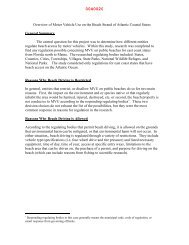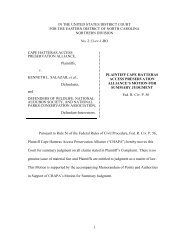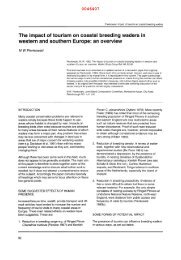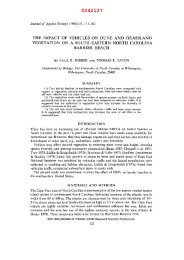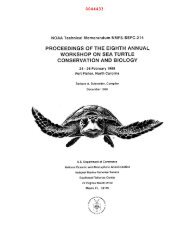Level Rise - Outer Banks Preservation Association
Level Rise - Outer Banks Preservation Association
Level Rise - Outer Banks Preservation Association
You also want an ePaper? Increase the reach of your titles
YUMPU automatically turns print PDFs into web optimized ePapers that Google loves.
0056631shipwrecks have occurred along the North Carolina coast since the 1600s (for more information seehttp://coastalguide.com/packet/shipwrecks01.htm or http://www.nps.gov/caha/shipwreck.htm).Storm impacts on coastal evolution along the <strong>Outer</strong> <strong>Banks</strong> are too numerous to detail here, but for acomprehensive overview of storms and storm tracks along the coast of North Carolina since 1933 see:http://www.erh.noaa.gov/er/akq/hist.htm. Also a summary of the recent impacts of Hurricane Isabel (September2003) is hosted by USGS at: http://coastal.er.usgs.gov/hurricanes/Isabel/.Six locations in and around the national seashore have been identified by the <strong>Outer</strong> <strong>Banks</strong> Task Force( http://www.obtf.org/ ) as erosional hot spots, or sections of coast where the dunes are frequently destroyed bystorms. Sections of North Carolina highway 12 have been relocated in these hot spot areas, and when breaks form inthe dunes they are immediately filled, which may interfere with natural barrier overwash processes. Some scientistssuggest that storms and overwash processes are essential to the evolution of these barriers, and human interferencethrough dune building, road maintenance, and breach filling only ensures an increase in vulnerability of theseislands (Dolan and Lins, 1986; Pilkey and others, 1998). Park managers, charged with resource preservation forfuture generations, are faced with a difficult task along the <strong>Outer</strong> <strong>Banks</strong>.This report does not directly address the vulnerability of the bay side shoreline of Cape Hatteras NationalSeashore to future sea-level rise, because the methodology presented here does not apply well to quieter water orestuarine wetland environments; however, the authors acknowledge the important issues impacting the Pamlico andAlbemarle Sound shoreline and direct interested readers to investigations on sea-level rise and estuarine shorelineerosion along the North Carolina Coast produced by Riggs (2001) and Riggs and Ames (2003).MethodologyIn order to develop a database for a park-wide assessment of coastal vulnerability, data for each of the sixvariables mentioned above were gathered from state and federal agencies (Table 2). The database is based on thatused by Thieler and Hammar-Klose (1999) and loosely follows an earlier database developed by Gornitz and White(1992). A comparable assessment of the sensitivity of the Canadian coast to sea-level rise is presented by Shaw andothers (1998). The database was constructed using a 1:70,000-scale shoreline for Cape Hatteras that was producedfrom the medium resolution digital vector U.S. shoreline provided by the Strategic Environmental AssessmentsDivision of the National Oceanic and Atmospheric Administration's Office of Ocean Resources Conservation andAssessment (http://spo.nos.noaa.gov/projects/shoreline/shoreline.html). Data for each of the six variables(geomorphology, shoreline change, coastal slope, relative sea-level rise, significant wave height, and tidal range)were added to the shoreline attribute table using a 1-minute (approximately 1.5 km) grid (Figure 2). Next eachvariable in each grid cell were assigned a relative vulnerability value from 1-5 (1 is very low vulnerability, 5 is veryhigh vulnerability) based on the potential magnitude of its contribution to physical changes on the coast as sea levelrises (Table 1).Geologic VariablesThe geomorphology variable expresses the relative erodibility of different landform types (Table1). Thesedata were derived from 1998 1-meter resolution digital aerial orthophotographs of Cape Hatteras (Tabale 2). Inaddition, field visits were made within the park to ground-truth the geomorphologic classifications. Thegeomorphology of Cape Hatteras varies from high vulnerability barrier island with dunes to very high vulnerabilitywashover-dominated barrier shoreline (Figure 3-10). A Hurricane Isabel impact study shows the barrier breach thatformed between Frisco and Hatteras Village on September 18, 2003 (Figure 11) (USGS, 2003). This breachoccurred in a washover-dominated very high vulnerability area. The U.S. Army Corps of Engineers and the NCDOTclosed the inlet and reconstructed Highway 12 during October and November of 2003.Shoreline erosion and accretion rates for Cape Hatteras were calculated from existing shoreline dataprovided by USGS (Table 2). Shoreline rates of change (m/yr) were calculated at 200 m intervals (transects) alongthe coast using Digital Shoreline Analysis System software to derive the rate of shoreline change over time (Thieler4



